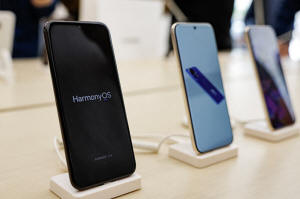Huawei starts sales of new Pura 70 smartphone to crowds amid chips
scrutiny
 Send a link to a friend
Send a link to a friend
 [April 18, 2024] By
Josh Ye, David Kirton and Brenda Goh [April 18, 2024] By
Josh Ye, David Kirton and Brenda Goh
HONG KONG/SHENZHEN/SHANGHAI (Reuters) - Chinese technology giant Huawei
started selling two models of its highly anticipated, high-end Pura 70
smartphone series on Thursday that many analysts expect to contain an
advanced China-made chip like its Mate 60 handset.
The Pura series developed by the Shenzhen-headquartered company has
advanced cameras and is known for its sleek design, while the Mate
series emphasises performance and business features.
The launch of Huawei's Mate 60 series last year was celebrated by
Chinese state media as a triumph over U.S. sanctions on the firm, as the
handsets contain an advanced China-made chip that is considered only a
few generations behind cutting-edge chips used by Western tech giants
like Apple and Google in terms of computing power.
Eric Xu, Huawei's acting chairman, on Wednesday told a forum in Shenzhen
that the company also plans to roll out a Mate 70 smartphone this year.
The Pro and Ultra versions of the Pura 70 were available on Thursday,
while the Plus and base versions will begin sales on April 22. The
phones were out of stock at Huawei's official online store just a minute
after sales started, and hundreds of the brand's fans lined up at Huawei
stores in Beijing, Shanghai and Shenzhen.
One customer, Lucas Zhuang, tested the network speed of the Pura 70 and
said it was at the level of 5G. Washington has banned the licensing of
5G chips to China but Huawei's Mate 60 phones were already able to
achieve 5G speed in many cases despite Huawei not branding it as 5G.

"We didn't know what chip the Pura 70 has inside. We only found out
after we bought it," Zhuang, who already owns the Mate 60, told Reuters
after waiting in line at Huawei's flagship store in Shanghai.
"But we believe ... the chip it has will certainly meet people's needs."
Ivan Lam, a senior analyst at research firm Counterpoint, said he
expected shipments of about 60 million units from Huawei this year, with
the Pura 70 series being an important catalyst. Last year, Huawei sold
about 32 million smartphones.
"There may be some shortage at various channels but supply will be much
better compared to when the Mate 60 was launched. We don't expect any
longlasting shortage," he said.

[to top of second column] |

A screen of the new Huawei Pura 70 series smartphone shows a sign of
Harmony operating system, as the series models go on sale at a
Huawei's flagship store in Beijing, China April 18, 2024. REUTERS/Tingshu
Wang

The Pura 70 series has four variants: the 70, the 70 Plus, the 70
Pro and the 70 Ultra. The starting price for the Pura 70 series is
5,499 yuan ($760.06).
CHIP CHALLENGE
The launch of the Mate 60 Pro last August sparked a spike in
Huawei's smartphone sales. According to Counterpoint, in the first
six weeks of 2024, Huawei saw unit sales rise by 64% year-on-year.
Meanwhile, Apple's iPhone sales in China fell 24% during the same
period.
Huawei’s Kirin 9000S chip was reportedly manufactured by China's
Semiconductor Manufacturing International Corporation (SMIC) despite
U.S. export restrictions seeking to limit Beijing's chip-making
capabilities.
It was seen as a symbol of China's technological resurgence despite
Washington's ongoing efforts to cripple its capacity to produce
advanced semiconductors.
The Biden administration began a review of the chip earlier this
year and said last month that SMIC might have violated U.S. export
rules, while adding it was still evaluating the situation.
Besides targeting China's chip manufacturers, the U.S. has imposed
trade restrictions on Huawei since 2018, viewing the company and its
products as a national security risk, which the company denies.
Elaborating on the pending Mate 70 smartphones on Tuesday, Xu said
the goal is for it to use a "pure" version of its HarmonyOS
operating system, developed in 2019 after U.S. sanctions cut
Huawei's access to U.S. technologies such as Google's Android.
HarmonyOS had still been reliant on the Android application
ecosystem but Huawei plans to cut that relationship and make
HarmonyOS completely independent and able to compete with Apple's
iOS and Android, he added.
($1 = 7.2350 Chinese yuan)
(Reporting by Josh Ye in Hong Kong, David Kirton in Shenzhen and
Brenda Goh in Shanghai; Additional reporting by Liam Mo in Beijing;
Editing by Jacqueline Wong, Stephen Coates, Jamie Freed and Sonali
Paul)
[© 2024 Thomson Reuters. All rights
reserved.]
This material may not be published,
broadcast, rewritten or redistributed.
Thompson Reuters is solely responsible for this content. |